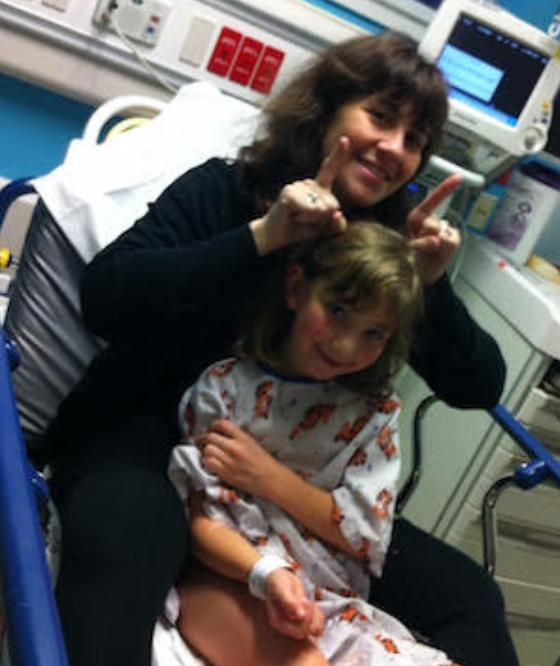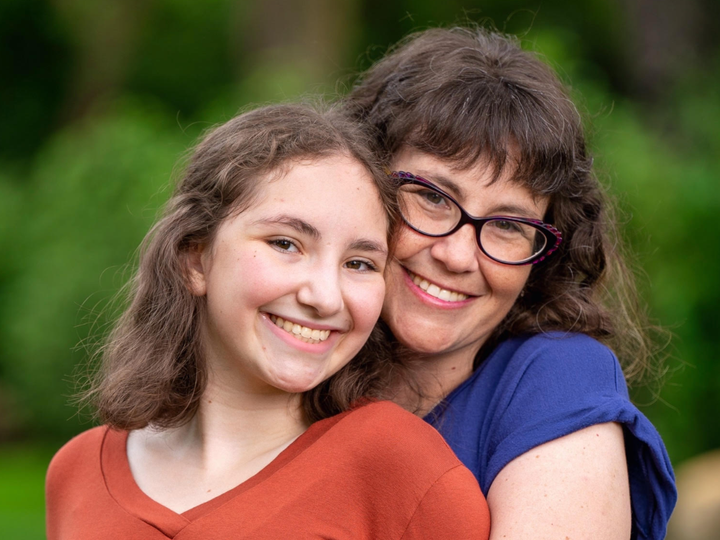
In November 2021, my heart pounded as I read that a jury awarded $21.5 million to the parents of Vivianne Marousek in a malpractice lawsuit over Vivianne’s treatment after a fall. Vivianne was discharged from Children’s Hospital and Medical Care in Omaha and went on to have seizures that left her blind, in a wheelchair and unable to communicate. During the same month, someone sent me an article about Scottish health officials in Lothian facing one of the largest malpractice suits in their history. According to The Scottish Daily Record, National Health Service offices in Lothian failed to diagnose 155 children with profound hearing loss or deafness, delaying their treatment for years.
As I read about both of these cases, I was filled with deep, aching empathy for the parents involved in these suits because of my own experience of improper medical treatment involving my daughter. From 2009 to 2014, my younger daughter, Sammi, was treated for a rare esophageal disorder called eosinophilic esophagitis. Treatments included extreme elimination diets, medications and more than a dozen endoscopies, each of which included multiple biopsies of her esophagus. After nearly five years of treatment with no resulting improvement in Sammi’s condition, a doctor admitted to us that he had not read her extensive medical chart, including information about a congenital heart defect that turned out to be the reason for her symptoms.
At first our fury was tempered only by our need for information and further treatment. With her doctor practicing in the best children’s hospital in our area, we were afraid that any action we took against him would keep Sammi from getting the care she needed. We held our breath as further testing confirmed the misdiagnosis; her symptoms were not caused by eosinophilic esophagitis but by structural malformations in her chest. We waited five months for the surgery that would correct them, never sure whether to fully trust that this, finally, would be the solution to her challenges with eating and swallowing.
But it was.
As we all recovered from her surgery ― physically for Sammi and emotionally for my husband, older daughter and me ― many of our friends and family members encouraged us to sue the doctors who had misdiagnosed her. After all, her recovery and newfound health were proof that she had been misdiagnosed in 2009. As I threw away the bags of strange ingredients from her elimination diets and watched her enjoy food in a way she never had before, the idea of a lawsuit was never far from my mind.
According to the American Board of Professional Liability Attorneys, a medical malpractice lawsuit must prove that a physician or other provider violated a medical standard of care and caused an injury that resulted in significant damages. For Sammi, these violations resulted in years of medical intervention she hadn’t needed, causing her to miss school dozens of times and putting her at risk for longer-term side effects of repeated anesthesia, some of which she did develop in the years that followed. In addition, my husband and I missed work for these procedures and clinic appointments and spent an exorbitant amount of money on specialty foods for her unusual diets, not to mention the cost of medications and medical copays for this illness that, it turned out, she’d never had. We were reasonably sure we would meet the criteria for a malpractice lawsuit.
But pursuing legal action just didn’t feel right to me. If lawsuits are intended to make a claimant whole in the eyes of the state, there seemed no way to achieve that for us. We could not get back Sammi’s lost years of malnutrition and missed school or our own endless hours of worry, fear and medical detective work. Because we are privileged enough to be able to pay for college when she’s older and because any issues stemming from those years were mild enough that we’d be unlikely to ever need money to solve them, a monetary settlement would not alter the course of her life or ours.
At the same time, I was angry and frustrated that we never heard a word from those doctors again: not a call to apologize, not even a response to a question about medications during her hospital stay for the surgery. As time went on, I felt shocked that we could endure and be forced to process this experience while the doctors could go on as though nothing happened.
“I was angry and frustrated that we never heard a word from those doctors again: not a call to apologize, not even a response to a question about medications during her hospital stay for the surgery.”
Several years before this, my friend Liz had endured the traumatic loss of her son in childbirth. After a long but seemingly uneventful labor, Liz’s son was delivered via forceps. By then, his heart had already stopped. Liz and her husband, Bruce, were, of course, devastated. For the sake of their toddler son at home, they wanted to know what had happened: why their baby had died and whether there was a genetic component that might affect their existing child. When Liz and Bruce pressed the hospital for details, the head of obstetrics and the CEO of the hospital met with them and assured them that genetic testing had turned up no abnormalities. “This happens sometimes,” they said.
Nursing her heartbreak and quickly becoming pregnant with another baby, Liz tried not to think about what might have gone wrong, but 14 months later, holding her healthy newborn daughter, she was asked by a friend who worked in a malpractice attorney’s office if she was interested in talking to the investigative nursing team there. Perhaps, her friend thought, Liz could learn something that would give her closure.
“Not knowing any answers was really hard,” Liz told me. “There was some piece of this puzzle that was missing, something that we didn’t know, and we didn’t have any way of finding out.”
When she and Bruce agreed to share Liz’s and their son’s records, it became obvious to the attorneys and to them that a communication breakdown had allowed a new shift of doctors to miss crucial information about their baby boy’s distress during labor. Though it was extremely painful to relive the experience, Liz and her husband decided to move forward with a lawsuit.
“The system in the United States with the medical community and the way they interact with the public, with private medicine and malpractice insurance and all that... it felt like especially as time went on that the only way one’s voice could be heard, to say ‘If you did something wrong, I want to know it... and do everything in our power to make sure it doesn’t happen again’ was to file a lawsuit,” Liz said. I could identify with her; the shocking lack of apology or acknowledgment from my daughter’s doctor ― surely an effort to avoid looking culpable, paradoxical as that is ― was a huge factor in our consideration of our own lawsuit.
In the end, Liz and Bruce settled with the hospital and the doctors, which gave them some relief ― just feeling that a settlement was an acknowledgment and validation of their experience. There were things Liz couldn’t share about the experience due to stipulations of their settlement ― like the doctors’ or hospital’s name, or details of the alleged malpractice ― but the money the hospital paid them helped them buy a home that would have been out of reach without it. Trauma their older son experienced from the loss and his parents’ grief required therapy, which the settlement helped cover financially. They were able to focus on their emotional healing and go on to have a life much freer from financial stress than they would have had otherwise.
I didn’t think much about Liz’s lawsuit until one afternoon about a year after Sammi’s final surgery. I was reading posts in a Facebook group for the families of children with her congenital heart defect when one post stopped me in my tracks.
A mother was lamenting that, after all her own child had endured in repairing the heart defect, now he had also been diagnosed with eosinophilic esophagitis. I was shaking as I wrote to alert her to the potential for misdiagnosis. If only Sammi had received one almost completely noninvasive test before being diagnosed with eosinophilic esophagitis, we would have discovered the root cause of the problem and avoided all those years of endoscopies.
I told her Sammi’s story, and she was as upset as I was. She assured me that she would reach out to her child’s doctor and ask about the test. As I lay in bed that night, I realized that if I could save another family from this terrible journey, it would give meaning to having endured it ourselves.

And that, in the end, was how I decided not to sue Sammi’s doctors. I worried that nondisclosure agreements or other silencing stipulations (often referred to as “gag orders”) would keep me from effecting any future change.
Sorry Works, a nonprofit that runs disclosure training for health care providers, wrote in its 2017 report on gag orders that “we believe mandatory gag orders are detrimental to learning and improvement across the American healthcare system... they also send a broader message to the healthcare industry that closed cases should be forgotten, or at least not shared between healthcare facilities. Gag orders are perceived to be part of the culture of secrecy that has dogged medicine.” Perhaps if more hospital systems agreed, both Liz and I would have received the compassionate responses to medical mistakes that we both deserved for our children.
In the end, with no comment from the doctors who had put my daughter through her years of misdiagnosis, I decided to share our experience more publicly. This month, my memoir of parenting Sammi through these years of misdiagnosis will be published. My deepest hope is that it will reach a parent like me, searching for answers in a pediatric medical mystery.
I don’t regret not suing Sammi’s doctors; for me, the richest reward would be a potential change in diagnostic protocols and a better outcome for other families. That said, I don’t think that’s possible in all cases or that the consequence for medical malpractice shouldn’t ever include a monetary settlement for the families devastated by it.
Psychologist Jo-Ann Finkelstein agrees with the no-size-fits-all answer to pediatric medical malpractice. “It’s a very personal decision,” she says. “When medical malpractice creates huge expenditures like medical bills, lost wages and future medical expenses, it’s usually more clear-cut. But when it’s more about punishing the physician or making sure it doesn’t happen to someone else, families need to decide if they want to expend the enormous energy it takes. Malpractice suits are expensive, time-consuming and emotionally draining.”
In the end, the way in which each family is made whole after medical tragedy is unique to that family. Some will find solace in the implied admission of “something fishy” that comes from a hospital settlement. Others will find their peace in advocacy and outreach. Most important is that the healing include an incentive for the medical system to do better ― next time.
Note: Some names have been changed in this piece to protect individuals’ privacy.
Debi Lewis is the author of “Kitchen Medicine: How I Fed My Daughter Out of Failure to Thrive” and has written for outlets including The New York Times, Bon Appetit, Huffington Post, Romper and Wired. You can learn more about her at http://www.debilewis.com and follow her on Twitter at @growthesunshine.
Do you have a compelling personal story you’d like to see published on HuffPost? Find out what we’re looking for here and send us a pitch.
